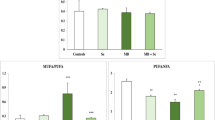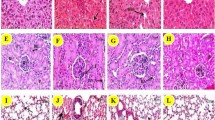Abstract
Selenium and zinc are well-known essential trace elements with potent biological functions. However, the possible health benefits of the combined administration of dietary selenium and zinc have not been studied extensively. In this study, we prepared selenium- and zinc-enriched mushrooms (SZMs) containing increased levels of selenium and zinc. The effects of SZMs on antioxidant and antitumor activities were evaluated. Mice were fed with either a control diet or a diet supplemented with SZMs or sodium selenite and zinc sulfate for 6 weeks. Antioxidant capacity was investigated by measuring the activities of antioxidant enzymes and the levels of lipid peroxide products. Results showed that treatment with SZMs significantly increased the activities of glutathione peroxidase (GPx) and superoxide dismutase and decreased the levels of malondialdehyde and lipofuscin. Furthermore, using a mouse model of lung tumors, we found that SZMs significantly decreased the number of tumor nodes with an increase in the activity of GPx. SZMs had a greater effect on the increase in both antioxidant and antitumor activities than did sodium selenite and zinc sulfate. These findings suggest that SZMs may be effective for improving antioxidant capacity and preventing tumors.




Similar content being viewed by others
References
Wellen KE, Thompson CB (2010) Cellular metabolic stress: considering how cells respond to nutrient excess. Mol Cell 40:323–332
Finkel T, Holbrook NJ (2000) Oxidants, oxidative stress and the biology of aging. Nature 408:239–247
Qadri I, Iwahashi M, Capasso JM, Hopken MW, Flores S, Schaack J, Simon FR (2004) Induced oxidative stress and activated expression of manganese superoxide dismutase during hepatitis C virus replication: role of JNK, p38 MAPK and AP-1. Biochem J 378:919–928
Rotruck JT, Pope AL, Ganther HE, Swanson AB, Hafeman DG, Hoekstra WG (1973) Selenium: biochemical role as a component of glutathione peroxidase. Science 179:588–590
Greenough MA, Volitakis I, Li QX, Laughton K, Evin G, Ho M, Dalziel AH, Camakaris J, Bush AI (2011) Presenilins promote the cellular uptake of copper and zinc and maintain copper chaperone of SOD1-dependent copper/zinc superoxide dismutase activity. J Biol Chem 286:9776–9786
Oteiza PI, Olin KL, Fraga CG, Keen CL (1995) Zinc deficiency causes oxidative damage to proteins, lipids and DNA in rat testes. J Nutr 125:823–829
Sahin K, Kucuk O (2003) Zinc supplementation alleviates heat stress in laying Japanese quail. J Nutr 133:2808–2811
Hu Y, Mclntosh GH, Le Leu RK, Young GP (2010) Selenium-enriched milk proteins and selenium yeast affect selenoprotein activity and expression differently in mouse colon. Br J Nutr 104:17–23
Moison RM, Beijersbergen van Henegouwen GM (2002) Topical antioxidant vitamins C and E prevent UVB-radiation-induced peroxidation of eicosapentaenoic acid in pig skin. Radiat Res 157:402–409
Honarbakhsh S, Schachter M (2009) Vitamins and cardiovascular disease. Br J Nutr 101:1113–1131
Beck MA (2007) Selenium and vitamin E status: impact on viral pathogenicity. J Nutr 137:1338–1340
el Jihen H, Imed M, Fatima H, Abdelhamid K (2008) Protective effects of selenium (Se) and zinc (Zn) on cadmium (Cd) toxicity in the liver and kidney of the rat: histology and Cd accumulation. Food Chem Toxicol 11:3522–3527
Messaoudi I, EI Heni J, Hammouda F, Said K, Kerkeni A (2009) Protective effects of selenium, zinc, or their combination on cadmium-induced oxidative stress in rat kidney. Biol Trace Elem Res 130:152–161
Puttaraju NG, Venkateshaiah SU, Dharmesh SM, Urs SM, Somasundaram R (2006) Antioxidant activity of indigenous edible mushrooms. J Agric Food Chem 54:9764–9772
Keenan JM, Goulson M, Shamliyan T, Knutson N, Kolberg L, Curry L (2007) The effects of concentrated barley beta-glucan on blood lipids in a population of hypercholesterolaemic men and women. Br J Nutr 97:1162–1168
Hetland G, Johnson E, Lyberg T, Bernardshaw S, Tryggestad AM, Grinde B (2008) Effects of the medicinal mushroom Agaricus Murill on immunity, infection and cancer. Scand J Immunol 68:363–370
Abdo KM (1994) NTP toxicity studies of sodium selenate and sodium selenite (CAS Nos. 13410-01-0 and 10102-18-8) administered in drinking water to F344/N rats and B6C3F1 mice. Toxic Rep Ser 38:1–E5
Batra N, Nehru B, Bansal MP (1998) The effect of zinc supplementation on the effects of lead on the rat testis. Reprod Toxicol 12:535–540
Kristiansen E, Clemmensen S, Meyer O (1990) Chronic ethanol intake and reduction of lung tumours from urethane in strain A mice. Food Chem Toxicol 28:35–38
Chan PC (1996) NTP technical report on toxicity studies of urethane in drinking water and urethane in 5 % ethanol adiministered to F344/N rats and B6C3F1 mice. Toxic Rep Ser 52:1–91
Yamamoto Y, Takahashi Y (1993) Glutathione peroxidase isolated from plasma reduces phospholipid hydroperoxides. Arch Biochem Biophys 305:541–545
Prohaska JR (1983) Changes in tissue growth, concentrations of copper, iron, cytochrome oxidase and superoxide dismutase subsequent to dietary or genetic copper deficiency in mice. J Nutr 113:2048–2058
Bradford MM (1976) A rapid and sensitive method for the quantitation of microgram quantities of protein utilizing the principle of protein-dye binding. Anal Biochem 72:248–254
Buege JA, Aust SD (1978) Microsomal lipid peroxidation. Methods Enzymol 52:302–310
Siakotos BL, Strehler AN (1974) Procedures for the isolation of lipofuscin (age pigment) from normal heart and liver. Methods Enzymol 31(Pt A):425–432
Li Y, Schellhorn HE (2007) New developments and novel therapeutic perspectives for vitamin C. J Nutr 137:2172–2184
Khandrika L, Kumar B, Koul S, Maroni P, Koul HK (2009) Oxidative stress in prostate cancer. Cancer Lett 282:125–136
Federico A, Iodice P, Federico P, Del Rio A, Melloine MC, Catalano G, Federico P (2001) Effects of selenium and zinc supplementation on nutritional status in patients with cancer of digestive tract. Eur J Clin Nutr 55:293–297
Cavdar AO, Gozdasoglu S, Babacan E, Mengubas K, Unal E, Yavuz G, Tacyildiz N (2009) Zinc and selenium status in pediatric malignant lymphomas. Nutr Cancer 61:888–890
Chu FF, Esworthy RS, Chu PG, Longmate JA, Huycke MM, Wilczynski S, Doroshow JH (2004) Bacteria-induced intestinal cancer in mice with disrupted Gpx1 and Gpx2 genes. Cancer Res 64:962–968
Liu J, Hinkhouse MM, Sun W, Weydert CJ, Ritchie JM, Oberley LW, Cullen JJ (2004) Redox regulation of pancreatic cancer cell growth: role of glutathione peroxidase in the suppression of the malignant phenotype. Hum Gene Ther 15:239–250
Baliga MS, Wang H, Zhuo P, Schwartz JL, Diamond AM (2007) Selenium and GPx-1 overexpression protect mammalian cells against UV-induced DNA damage. Biol Trace Elem Res 115:227–242
Loiseaux-Meunier MN, Bedu M, Gentou C, Pepin D, Coudert J, Caillaud D (2001) Oxygen toxicity: simultaneous measure of pentane and malondialdehyde in humans exposed to hyperoxia. Biomed Pharmacother 55:163–169
Bjelakovic G, Nikolova D, Simonetti RG, Gluud C (2004) Antioxidant supplements for prevention of gastrointestinal cancers: a systematic review and meta-analysis. Lancet 364:1219–1228
Bromme CS, McArdle F, Kyle JA, Andrews F, Lowe NM, Hart CA, Arthur JR, Jackson MJ (2004) An increase in selenium intake improves immune function and poliovirus handling in adults with marginal selenium status. Am J Clin Nutr 80:154–162
Hoffmann FW, Hashimoto AC, Shafer LA, Dow S, Berry MJ, Hoffmann PR (2010) Dietary selenium modulates activation and differentiation of CD4+ T cells in mice through a mechanism involving cellular free thiols. J Nutr 140:1155–1161
Murakami M, Hirano T (2008) Intracellular zinc homeostasis and zinc signaling. Cancer Sci 99:1515–1522
Brown GD, Gordon S (2003) Fungal beta-glucans and mammalian immunity. Immunity 19:311–315
Yan H, Kakuta S, Nishihara M, Sugi M, Adachi Y, Ohno N, Iwakura Y, Tsuji NM (2011) Kjellmaniella crassifolia Miyabe (Gagome) extract modulates intestinal and systemic immune responses. Biosci Biotechnol Biochem 75:2178–2183
Acknowledgments
This study was supported in part by funds from the Fifth Hospital of Shijiazhuang.
Conflict of Interest
The authors declare that they have no conflict of interest.
Author information
Authors and Affiliations
Corresponding author
Rights and permissions
About this article
Cite this article
Yan, H., Chang, H. Antioxidant and Antitumor Activities of Selenium- and Zinc-Enriched Oyster Mushroom in Mice. Biol Trace Elem Res 150, 236–241 (2012). https://doi.org/10.1007/s12011-012-9454-1
Received:
Accepted:
Published:
Issue Date:
DOI: https://doi.org/10.1007/s12011-012-9454-1




